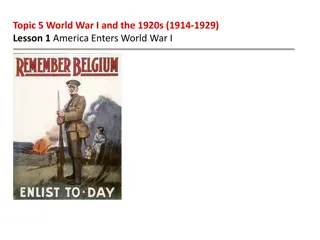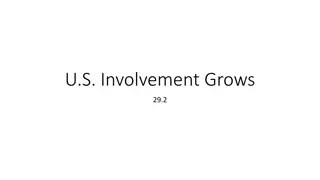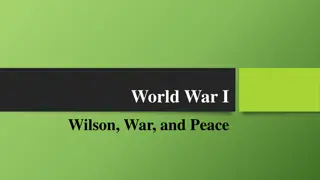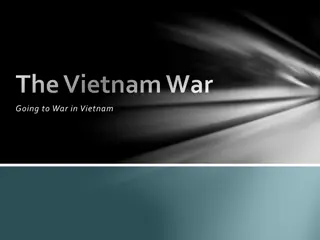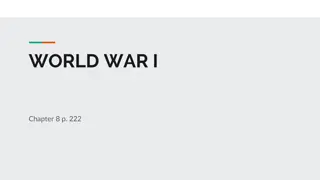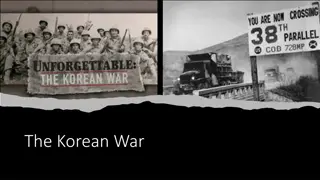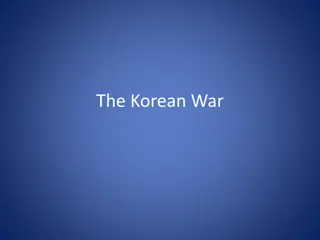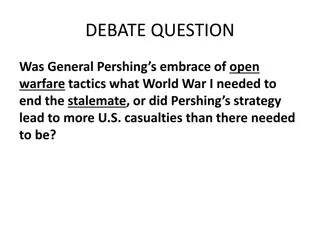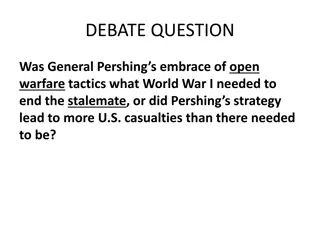America's Entry into World War I: Causes and Impacts
World War I and the 1920s witnessed America's transition from neutrality to active involvement in the war. Factors such as nationalism, militarism, imperialism, and alliances led to the conflict. The impact of technological innovations resulted in stalemate on the Western Front, leading to significa
10 views • 11 slides
The Americanization of the Vietnam War: Escalation and Challenges
In February 1965, President Johnson escalated U.S. involvement in the Vietnam War through Operation Rolling Thunder, intensifying bombing campaigns and increasing troop commitments. This shift in strategy, driven by American assumptions and General Westmoreland's counsel, aimed to Americanize the wa
4 views • 12 slides
World War I: US Entry and Convoys Changing the Tide
World War I had reached a deadly stalemate on the Western Front until the US entered the conflict, providing the Allies with crucial support. The adoption of convoy systems helped protect shipping and significantly reduced losses from German U-boat attacks. However, the struggle continued as the Cen
3 views • 27 slides
The Vietnam War: American Involvement and Escalation
The Vietnam War saw deepening American involvement, from military advisors under Eisenhower to troop deployments and sustained bombing campaigns under Kennedy and Johnson. The conflict escalated with political turmoil in Vietnam, the Gulf of Tonkin Resolution, and the emergence of a bloody stalemate
0 views • 10 slides
Causes and Outbreak of World War I
Various factors such as nationalism, imperialism, militarism, and the assassination of Archduke Francis Ferdinand led to the outbreak of World War I. The tensions in Europe escalated as countries formed alliances and mobilized for war. The conflict resulted in early battles like the Battle of Marne
0 views • 23 slides
The Korean War: Causes, Participants and Consequences
The Korean War began after Japan's defeat in WWII when the country was divided at the 38th parallel. It started as a conflict between North Korea, supported by the USSR, and South Korea, backed by the U.S. The war ended in a stalemate with an armistice, leaving North Korea communist and isolated, wh
3 views • 5 slides
The Korean War: A Conflict Dividing Nations
At the conclusion of World War II, Korea was temporarily divided into Soviet-occupied North and American-occupied South zones. The Korean War broke out in 1950 when North Korean troops crossed the 38th parallel. United Nations forces intervened, leading to a stalemate with Chinese involvement. Gener
1 views • 5 slides
General Pershing's Strategy in World War I: Ending the Stalemate or Increasing Casualties?
General Pershing's embrace of open warfare tactics in World War I sparked a debate on whether his strategy was the key to breaking the stalemate or if it led to unnecessary U.S. casualties. His preference for hand-to-hand combat over trench warfare raised questions about the effectiveness of traditi
4 views • 4 slides
General Pershing's Strategy in World War I: Ending Stalemate or Causing More US Casualties?
Explore General Pershing's embrace of open warfare tactics in WWI, debating whether it helped end the stalemate or resulted in excessive US casualties. Analyze Pershing's shift from trench warfare to open combat, assessing its impact on the conflict's outcome and casualties.
0 views • 4 slides
